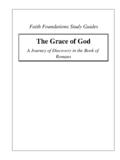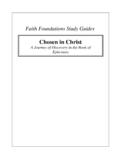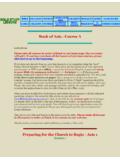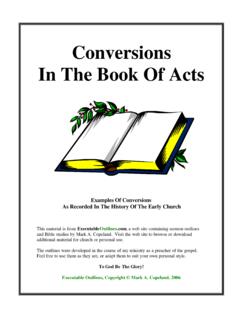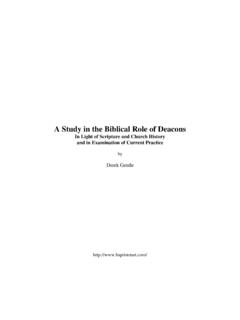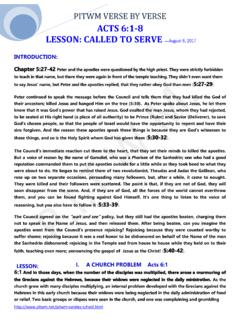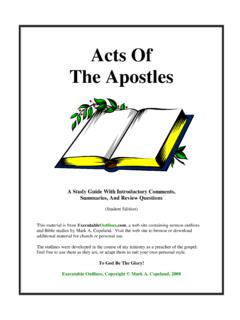Transcription of The Progress and Power of the Gospel - …
1 The Progress and Power of the Gospel A Journey of Discovery in the Book of acts Faith Foundations Study Guides Alan Perkins 2018 All rights reserved. Printed in Scriptures taken from the Holy Bible, New International Version , NIV Copyright 1973, 1978, 1984, 2011 by Biblica, Inc. Used by permission. All rights reserved worldwide. How to Use This BookWelcome to the Faith Foundations study guide on acts ! Whether you are just beginning your new life with Christ, or have been a Christian for many years, this study guide is for you. It is designed to help you discover, through personal study and group discussion, the incredible riches of God s Word, and to help you grow in your walk with God by applying what you learn. This book is divided into 26 lessons, each of which contains the full NIV text of the Scripture passage, several study and discussion questions, and a verse-by-verse commentary.
2 So, together with a Bible to look up cross-references, you have everything you need for your "journey of discovery" in acts . Why Small Groups? These materials can be used profitably in personal study or in an adult Sunday School class. But their value will be best realized when they are used in small groups, meeting either at church during the Sunday School hour or in homes during the week. There are several reasons for this. First, no one has perfect insight into every passage of Scripture; we can all benefit from hearing the perspectives of other believers as we seek to understand and apply the Bible. A small group gathering, using the discussion questions included in this book, is an ideal way to stimulate a sharing of observations and ideas. Second, a small group provides a community of fellow travelers who, along with us, are seeking to follow Christ in the midst of family responsibilities, job pressures, and personal struggles.
3 In today s fragmented and mobile society, the natural networks of neighborhoods and family no longer provide the support they once did. We need some way of making connections with others for mutual support, people with whom we can share our joys and sorrows people who will listen, who will pray with us, who will offer a helping hand and a word of encouragement, and who will confront us in love when we ve gotten off track. Finally, a small group combines the benefits of Biblical insight and community support by keeping us accountable. If we only study the Scriptures alone, or listen to them taught in a large group, it s easy to let them go "in one ear and out the other". But when a small group of people are learning the same things at the same time, they can help one another to apply the things they are learning. How Are the Groups Organized?
4 The groups should be composed of 6-14 people: if they are smaller, any absences can make it difficult to maintain the discussion; if they are larger, not everyone can participate. You can meet from two to four times a month; if the group meets less than twice a month, the members aren t spending enough time together to build relationships. Some groups find that meeting three times a month during the school year, with a break during the summer, provides a good rhythm of involvement and time off. You may choose to include a mix of married and single, older and younger members, or you may organize your groups by age or marital status. There are benefits to homogeneous groups in which the members are going through similar life experiences, but there are also benefits of a diverse group in which the younger members can benefit from the experience of the older.
5 Each group needs to have a recognized leader, preferably one selected and trained by the pastor or church leadership. This person s role during the meeting is not primarily to teach (although preparation of the lesson is a must), but to guide the discussion and keep the group from getting bogged down on side issues. He or she does not need to be the host; in fact, it is preferable that group responsibilities, such as providing a home in which to meet and organizing refreshments, be shared among the members. Finally, membership in the group should be based on three commitments: To prepare for each meeting by completing the lesson in advance, which takes from 1/2 to 2 hours (but come to the meeting even if you haven t done the lesson); to place a high priority on regular attendance and come to the meetings except in case of emergency; and to keep confidential anything of a personal nature which is shared during the meetings (except when it is necessary to communicate concerns to the pastor).
6 What Is the Group Meeting Like? Each group meeting should last from 1 1/2 to 2 hours, and provide time for discussion of the lesson, prayer, and fellowship. A problem in many groups is for the lesson to take up most of the time, with only a few minutes left over for prayer and fellowship. This must be avoided for the goal of building relationships to be achieved. Here is a suggested schedule: 15 minutes: Gathering 30-45 minutes: Discussion of the lesson 20-30 minutes: Prayer 15-30 minutes: Refreshments As for child care, experience has shown that in order to receive the maximum benefit from time spent in the meeting, all members of the group need to be free to focus on the discussion, rather than caring for children. Therefore, with the possible exception of infants under one year, parents should make arrangements for child care during the meetings.
7 Some options include "trading" child care with parents whose group meets on a different night, having a baby sitter care for children in another room during the meeting, or providing child care for all the groups at the church. Introduction to ActsAuthor The author of acts is not named in the book; however, early Christian tradition and other internal evidence both point strongly to Luke, the author of the third Gospel (see Luke 1:1-4; acts 1:1). Traditional references to Lucan authorship include the Muratorian Canon (AD 170-180), Irenaeus, Against Heresies (AD 175-185), and the Anti-Marcionite Prologue to the Third Gospel (late second century). As for internal evidence, the author implicitly identifies himself as a participant in several of the events recounted in acts , using the personal pronoun we in 16:10-17; 20:5-15; 21:1-18; and 27:1-28:16.
8 Paul s letters identify Luke as being one of those present with him during his time of imprisonment in Rome (Col. 4:14; Phlm. 23-24), and although this is not definitive, since Luke was not Paul s only companion, the agreement of the internal references with the unanimous testimony of the early external witnesses allows us to confidently identify Luke as the author. Occasion and Purpose If acts is the second volume of a two-part project, Luke- acts , we can find the purpose statement in Luke 1:1-4. It was Luke s intention to write a carefully investigated and orderly account of the things that have been fulfilled among us , in order that its recipient, Theophilus, might know the certainty of the things you have been taught. In other words, Luke s purpose was to write a well-researched, historical account of the life and ministry of Christ, and of the continuing work of the Holy Spirit after his resurrection and ascension into heaven.
9 He did so in order to confirm for Theophilus the validity of the Christian teachings he had received. Date The earliest quotations from, or allusions to, the text of acts in other known writings come after AD 150. Thus, an earlier date for the book can only be arrived at from internal evidence. If written by Luke, a date not many years after the events recorded in acts is likely, unless he was very young at the time they occurred. This would date the book sometime after the conclusion of Paul s imprisonment, which ended in AD 62. An argument from silence suggest that since the author does not mention the intense persecution of Christians in Rome which began under Nero, a date earlier than AD 64 is warranted. Major Themes David G. Peterson, in his commentary The acts of the Apostles, identifies several theological emphases, including these: 1.
10 God. God is the creator and sustainer of all things, including the heavens and the earth (4:24; 14:15, 17; 17:24-25). He is sovereign over the affairs of mankind (14:16; 17:26), and will judge the nations (10:42; 17:30-31). However, he desires a relationship with human beings (17:27). He is not confined to specific buildings, nor can he be approached via idols or man-made systems of religion (7:48-50; 17:24-29). 2. Jesus. The same Jesus whose life, ministry, death and resurrection were depicted in Luke s Gospel is now alive, and present and active in the world through his Spirit (1:1-5). He is Lord of all (10:36), Messiah (2:36), and the Savior of those who turn to him in repentance and faith (2:38; 3:19-20; 4:12; 13:38-39). 3. The Holy Spirit. The Holy Spirit is the Spirit of Jesus (16:7), who is given to all believers (2:38-39).
